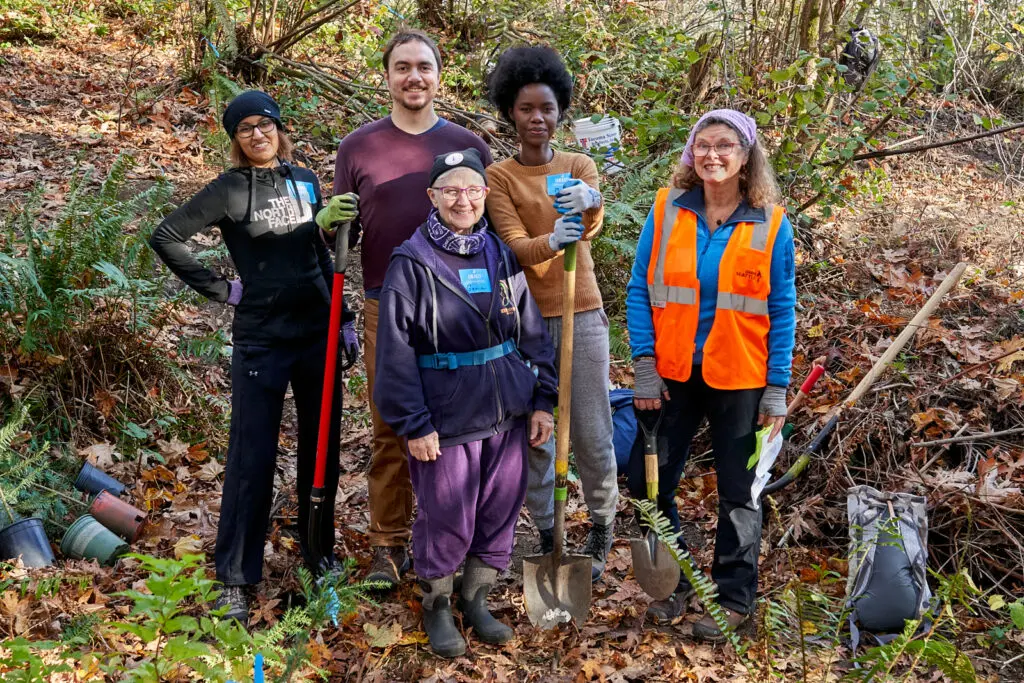Forterra purchased 344-acres of forest land along Sawmill Creek from Plum Creek Timber Company for permanent conservation in December 2012. The Sawmill Creek property was the largest privately-owned swath of old growth forest left in the Green River Valley and contains habitat for spotted owl and other wildlife species.
Conservation for Watershed and Wildlife
This project helps connect habitat with other conserved forests of the Central Cascades in the Cedar River Watershed, Alpine Lakes Wilderness and Mt. Rainier National Park.
“The conservation of Sawmill Creek is a huge benefit for our region’s environment and ensures that another great piece of forestland will provide high quality habitat for our wildlife in this corridor connecting the north and south Cascades,” said Gene Duvernoy, Forterra president.
Duvernoy continued, “Our collaboration with Tacoma Water, Plum Creek, Department of Natural Resources and U.S. Fish and Wildlife Service and other partners is another success and helped advance the goals of the Cascade Agenda, our long-term plan for this region’s sustainable environments, economies, and communities.”
On Dec. 27, ownership of the property was transferred to Tacoma Water. Sawmill Creek is located in the upper Green River Valley, the drinking water supply for Tacoma. Tacoma Water will maintain the forest habitat in perpetuity as part of their watershed management.
“Tacoma Water welcomes the donation of this property, so that we can protect the forest and the clean water flowing from it,” said Linda McCrea, Tacoma Water’s Superintendent. “This fits well in the long term management of our lands in the upper Green River watershed to keep our water supply clean and provide quality habitat for wildlife. It builds on earlier acquisitions in Sawmill Creek facilitated by Forterra and other conservation groups.”
“Plum Creek is pleased to be a part of this acquisition that supports the habitat conservation plan on our Cascade lands. For the past two decades, Plum Creek has cooperated with Forterra, Trust for Public Land, The Nature Conservancy and land management agencies to transfer important habitat lands into public ownership,” said Jerry Sorensen, Senior Director- Land Asset Management for Plum Creek.
“Partnerships such as this one are critical to preserving and protecting conservation lands such as Sawmill Creek,” said Peter Goldmark, Commissioner of Public Lands. “We are happy to do our part to make this project a success.”
I-90 Wildlife Corridor
This land purchase is part of the larger I90 Wildlife Corridor conservation project, a plan being implemented in conjunction with the Washington Department of Transportation’s (WSDOT) ongoing expansion of a 15-mile stretch of the interstate highway, just east of Snoqualmie Pass between Hyak and Easton. The highway expansion will help reduce traffic problems and improve road conditions, freight mobility, safety and ecological connectivity. As part of the expansion, WSDOT is building wildlife bridges at strategic points to allow animals to safely cross over or under the highway. This will also increase safety for drivers.
In order to improve the effectiveness of the bridges, Forterra , the I90 Wildlife Bridges Coalition, the U.S. Forest Service, Washington Department of Fish and Wildlife and groups like the Sierra Club have been conserving strategic pieces of land containing high-quality habitat corridors in areas complementing other public land. Sawmill Creek is part of the habitat corridors that lead to these bridges, a few miles to the east. With the conservation of Sawmill Creek, Forterra has conserved over 2000 acres in support of the Wildlife Corridor project.
Grant Funds
Forterra purchased Sawmill Creek using grant funds from the US Fish and Wildlife Service. Authorized by the Endangered Species Act, the Cooperative Endangered Species Conservation Fund (CESCF) provides grants to support federally approved habitat conservation plans (HCPs). Projects that acquire habitat for endangered species, such as the I-90 Wildlife Corridor are among those eligible. It is administered by the U.S. Fish and Wildlife Service. Projects compete for the grants on a national basis each year.
“The I-90 Wildlife Corridor Project has been a high priority for the Fish & Wildlife Service,” said Ken Berg, USFW Washington State director. “Over the past six years, we have provided over $10 million to support the acquisition and protection of key habitat lands in strategic locations that support the habitat conservation plans and provide habitat connections for endangered species. This is especially important as these forests respond to climate changes.”
###
ABOUT FORTERRA
Forterra is an unconventional land trust that works across Washington’s communities and landscapes, from the ranches and shrub-steppe of the Yakima basin, to the estuaries, farms and forests of Washington’s coast, reaching more than 100 counties, cities, towns and rural communities. Working cooperatively with people and nature, Forterra drives land stewardship, management and planning; innovative programs and policies; farming and forestry approaches; community ownership opportunities; and development solutions. Visit www.forterra.org.



